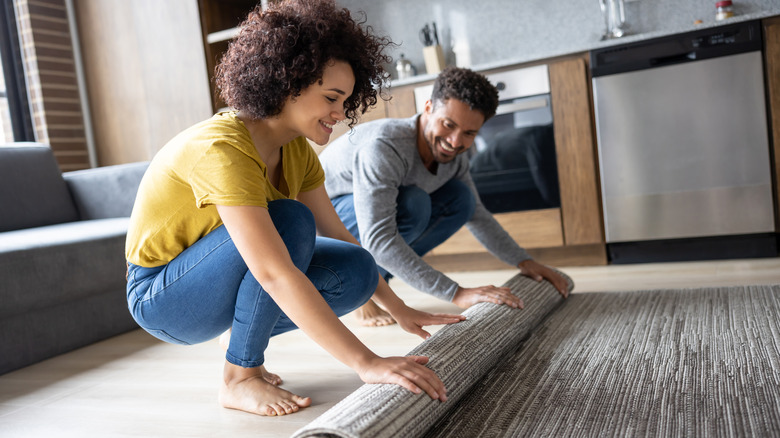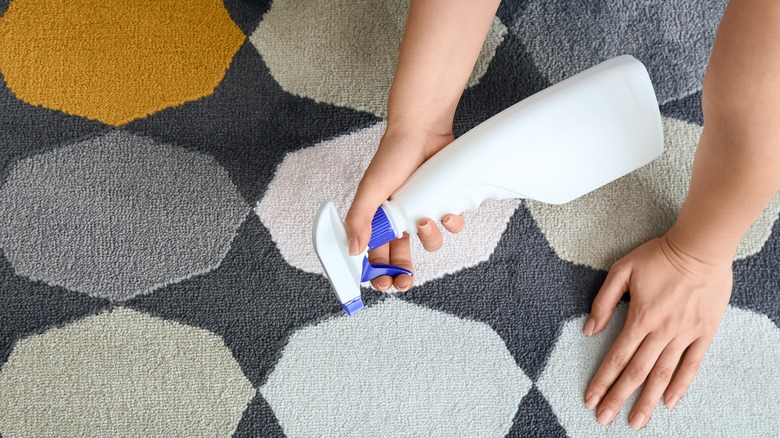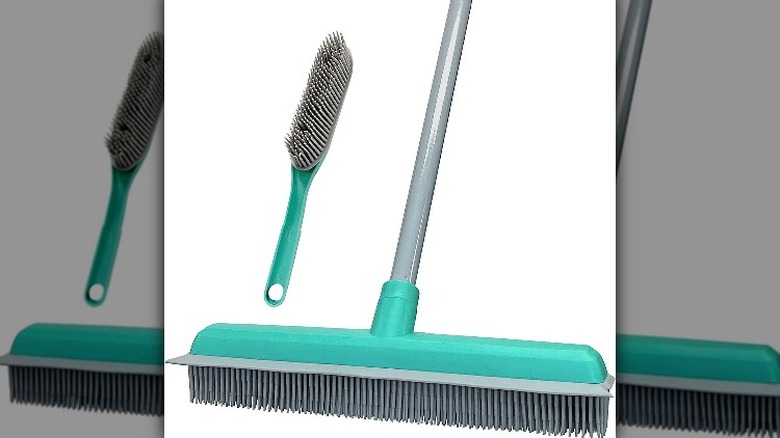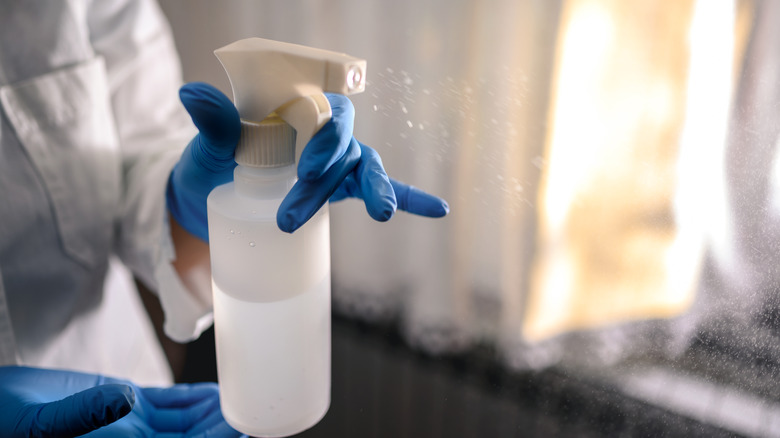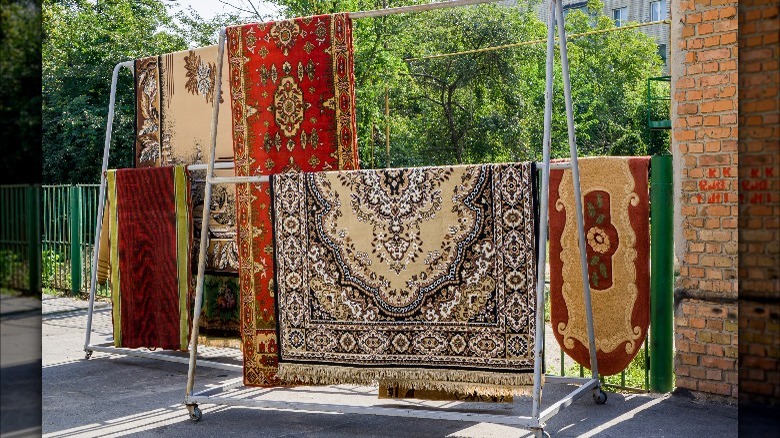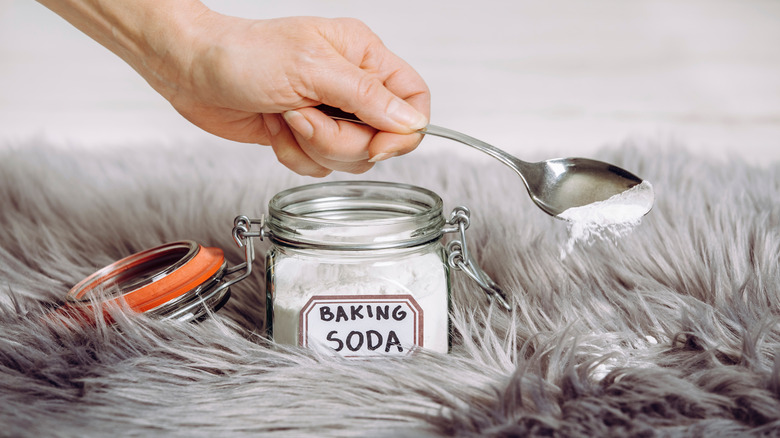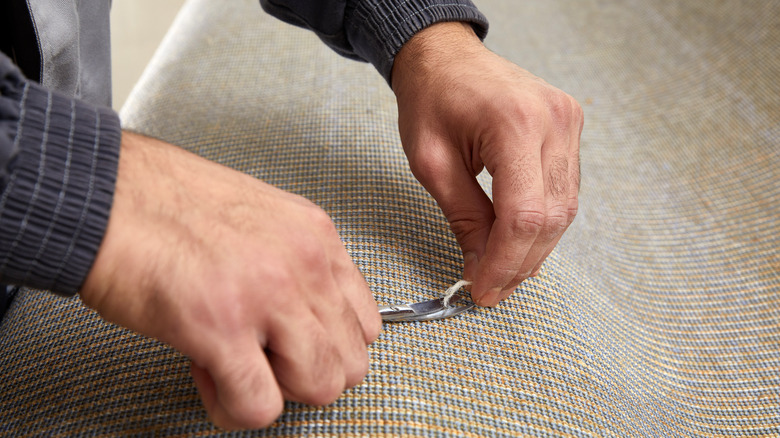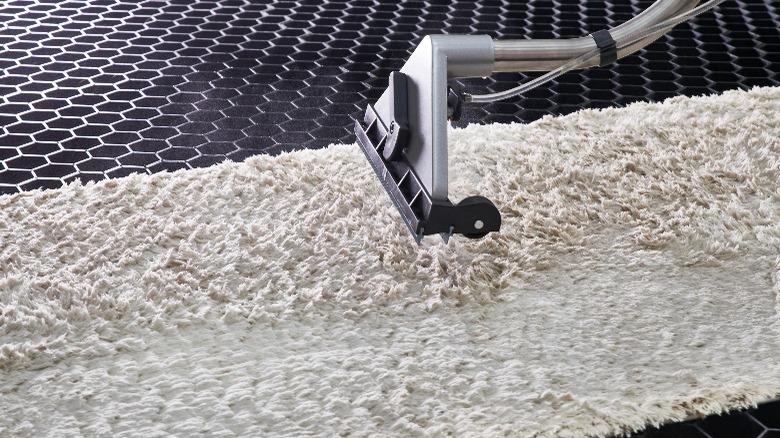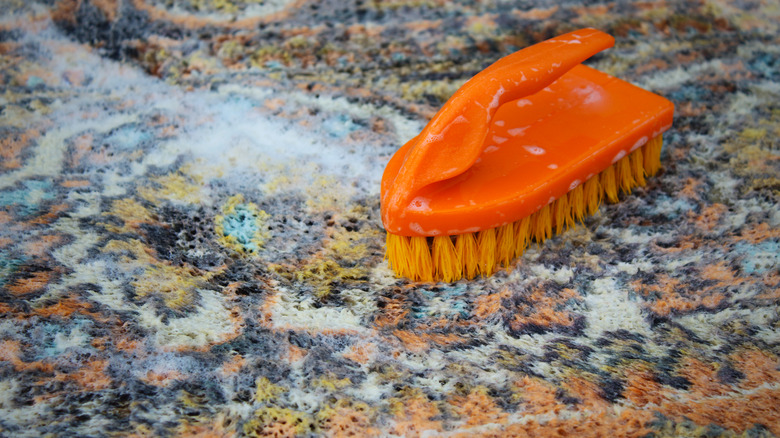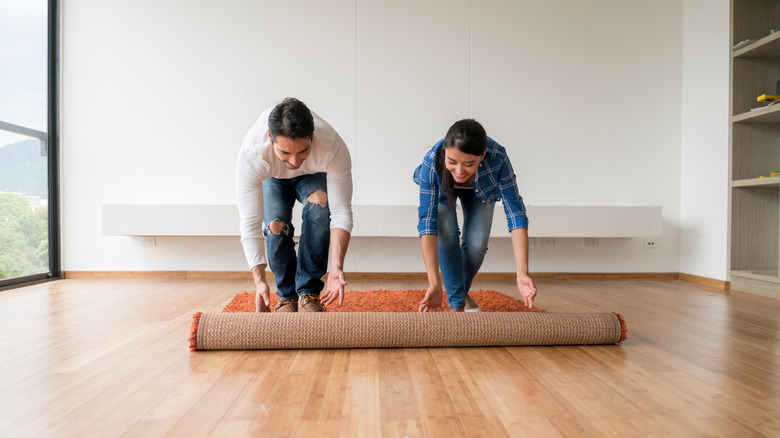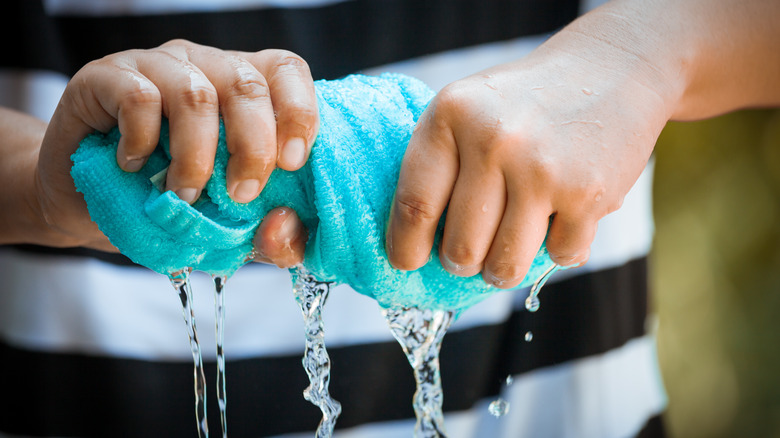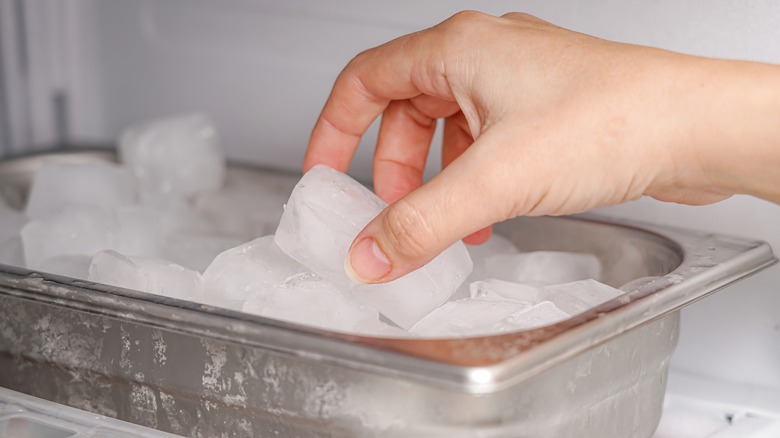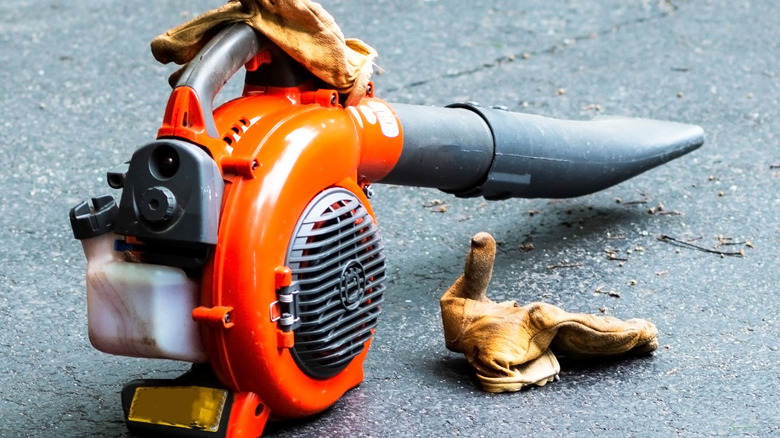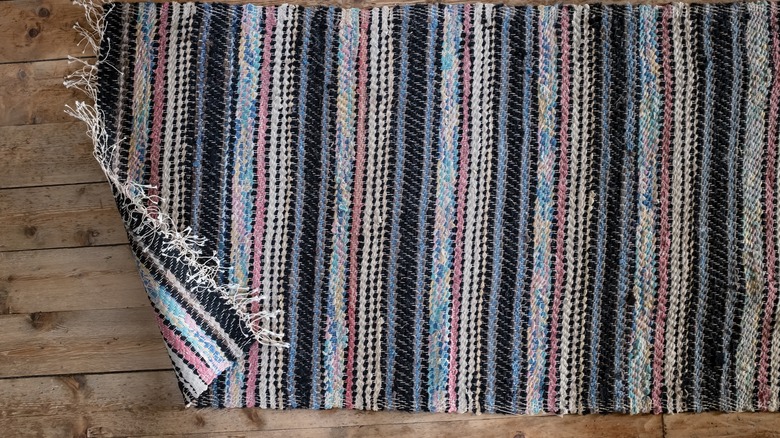Game-Changing Tips To Keep Your Rugs Pristine
We may receive a commission on purchases made from links.
In today's constant hustle and bustle, keeping up with home decor maintenance might seem like a low priority. However, with just a few tricks and changes to your regular cleaning routine, it can be a breeze to keep the rugs in your home looking as fresh as the day you bought them.
Your rug can build up plenty of unsightly — and even smelly — debris over time. These particles hail from various sources, such as on pets, and are tracked in from the outside on shoes. This can look dirty at best and can cause serious irritation when it comes to allergies and respiratory issues at worse. A regular cleaning routine can help keep your rugs looking fresh overall, helping to maintain a stylish and healthy environment.
These tips cover everything from regular maintenance to handling tough stains and other damage. To prolong their lifespan and preserve the aesthetic appeal of your rugs, you'll likely need to do more than vacuum regularly. Here, learn about the importance of spot cleaning, deep cleaning, and how far a few special tools and tricks can go.
Limit odors with natural scents
Limiting odors is essential when keeping your space feeling pristine. However, eliminating pesky smells doesn't have to cost a fortune or fill your home with toxic chemicals or fragrances. One natural solution to tough odors that can settle into fabrics and rugs around your home is through the use of essential oils.
Essential oils have been used for centuries for various purposes, including aromatherapy, cleaning, and naturally fragrancing homes. You can easily brew up your own natural freshener spray by blending several drops of your favorite essential oil with baking soda and water in a spray bottle. Alternatively, you can mix your essential oils with vinegar and water which can also work as an all-purpose deodorizer. Don't worry, once the vinegar dries, the smell evaporates as well. Simply spritz a thin layer of either solution on your rug, and allow the tough odors to evaporate away as it dries.
Use a rubber bristle broom or brush to remove hair
Even a high-powered vacuum cleaner can struggle to lift and remove large amounts of embedded pet hair, which means your favorite rug can quickly go from pristine to putrid. As it accumulates it attracts and traps more dust and dander causing build-up. This combo can seriously diminish the air quality inside your home, irritating allergies and more. Using a rubber-bristled tool is a great trick for lifting hair from your rugs without releasing them into the air or stirring up debris.
The rubber bristles create a static cling effect and actually attract pet hair and dust, pulling them from the carpet fibers. Additionally, these rubber bristles are a breeze to clean with just soap and water, which means you can skip expensive vacuums and attachments for removing pet hair and still keep your home neat and clean. Adding this simple step to your routine can reduce your vacuuming time and help with re-fluffing fibers to keep them looking like new. Plus, you can pick one of these brushes up for under $20, making it a budget-friendly way to protect your home's air quality while also maintaining the appearance of your rugs.
Use an antibacterial spray
Rugs in high-traffic areas and can amass a large amount of dirt and dust from the outside world. As we walk across rugs, wipe our shoes on them, and place items on top of them, we're transferring dirt, bacteria, viruses, and fungi. Although most germs and bacteria are microscopic organisms, over time they can discolor and stain our rugs, wear them down, and embed unpleasant odors. To counteract some of these contaminants, a simple antibacterial spray can help kill harmful germs and bacteria. While these aren't usually needed as often as vacuuming and deodorizing, they can be especially helpful after a sickness has made its way through your home. They are also a good way to keep rugs germ-free if you have little ones crawling around.
When selecting an antibacterial spray, make sure to choose one that suits the specific materials and fabrics used in your rugs. Check the spray bottle as well as the rug manufacturer's instructions. Lysol makes a fabric disinfectant spray that's designed to eliminate 99.9% of germs on rugs while adding a soft lavender scent. And, Clorox has a formula created without fragrances and dyes that they say can both kill germs and tackle dander and dust mites.
Treat them to UV rays
Fresh air and sunlight can do wonders on any fabric or material that holds germs and bacteria. When the sun is out and there's no chance of rain, start by vacuuming your rug. Then, secure them over a railing or clothesline where you can shake out the sides easily. Then, allow the rays from the sun to tackle certain types of bacteria hidden in the fibers.
If your rug is too large to hang outside, or the weather isn't on your side, you can still use some UV rays for disinfecting. A study by The Ohio State University researchers reported by Science Daily found that UV light reduced the microbes on carpet by 87 percent, 9 percent more than vacuuming alone. So if you'd like to harness the sun's power indoors, you can even purchase a vacuum with an integrated UV light like Omni Air's UV+ cordless stick model.
Use baking soda to absorb dirt and odors
Vacuuming and spot cleaning can accomplish a lot. However, removing deep-rooted dirt can be difficult and it can build up quickly. A common household product, baking soda, can be another inexpensive way to freshen up your rugs. You might already know that it's a natural deodorizer that doesn't just hide odors but neutralizes them. The powder is also great at absorbing moisture, dirt, and oil making it a must-use cleaning tool for textiles.
Plus, baking soda is inexpensive and non-toxic, already outranking other cleaning products. First, do a patch test on an inconspicuous area of your rug to ensure the color won't be damaged. Then, simply sprinkle the powder loosely over your carpet, making a slightly thicker layer over tough stains, and let it work its magic for a few minutes up to overnight. When it's time to vacuum it up, make sure you pass over the entire surface twice, lifting odors and debris as you go.
Trim loose strings and strands
One mistake when maintaining the look of your rugs is to let unsightly loose strands continue to unravel from fear of making them worse. These can occur over time because of normal wear and tear, excessive vacuuming, or even unruly pets. Fortunately, if you catch them early, you can often prevent some unsightly damage. If you have a cut pile rug, which means that the ends of the carpet fibers are loose, you can typically trim any loosened strands down with sharp scissors. Then, gently pull the strand until it's as even as possible with the rest of the fibers.
However, if you have a loop pile rug, like flatweave or hand-hooked wool options, you'll want to take your rug to a pro for mending. Not only does this style show more defects, making it more difficult to fix. But the loops are made with long, continuous pieces, meaning that a misplaced snip can ruin the whole rug.
Don't skip shampooing your rug
Vacuuming can certainly help reduce the amount of muck in your rug, but it can be next to impossible to remove all of the particles. Every once in a while, a deep clean is necessary. Shampooing your area rug is recommended about once a year. However, the method is just as important as the frequency. First, check the tag on the underside of the rug for cleaning instructions. Generally, if you have one made of natural fiber, like jute, a cool water rinsing process and gentle soap can help maintain the delicate form. However, with other materials, your standard carpet cleaner can do the trick. Scott Johnston, owner of Carpet Care of the Carolinas, tells Architectural Digest, "You can be much more aggressive when cleaning synthetic rugs, as they can handle hot water and stronger cleaning solutions." But it's still recommended to use a specialized rug cleaner, rather than basic carpet shampoo, in the machine.
However, there are times when a deep clean is never something you should tackle at home. With delicate and specialty materials, it's best to take your rug to an expert to prevent ruining it. As Ali Hafezi Mashhadi, vice president of Babash Rug Services, tells Architectural Digest, "In general, Persian and Oriental rugs, as well as rugs made of silk or viscose, should only be professionally cleaned."
Spot clean
Spot cleaning, or giving a little extra care and attention to stains will go a long way. Accidents occur, and stains are inevitable, but taking quick and decisive action can prevent permanent damage to your rugs. A great way to maintain your carpets is to have a cleaning spray on hand that you can apply quickly if a spill happens. Products such as Puracy Instant Spot Remover and Carpet Cleaner can quickly break down a stain and prevent further damage. Absorb any excess liquid by blotting gently so as to not push the stain deeper. Then, gently work the solution into the stain and wipe it away.
If you want to use a drier option, you can spray a product like Bissell's Heavy Traffic Carpet Foam onto the rug's surface. This helps to remove dirt and cleans the carpet fibers. Work the foam into the rug, then simply vacuum it away, and it will leave a stain-fighting barrier on the carpet's surface.
Rotate your area rugs
Another trick to keeping your rugs looking spic and span is to rotate them regularly. If you've ever rearranged your furniture, you've probably noticed that certain areas of your rug are in better condition than others. That's because some areas are practically untouched under furniture and close to walls, while others are routinely stepped on and walked over. If you rotate your area rugs periodically, you can effectively distribute the wear and tear over the entire rug. High-traffic areas, such as hallways and doorways, are prone to accumulating more dirt and debris than other rooms in your home, so pay special attention to those areas.
Shifting your rugs every six months is a good rule of thumb to ensure they wear evenly. In addition, pay particular attention to rugs that have been exposed to direct sunlight, as this can cause the colors to fade over time.
Use a damp towel to re-fluff them
Area rugs can add warmth and personality to your space that takes your decor to another level. However, as time passes the fibers and materials can be flattened and trampled, making them look old and worn. This is a particular problem with shaggy, loose rugs that have longer threads and fibers. If you're looking to bring your shaggy rug back to life, try using a damp towel to re-fluff it.
This trick requires little effort but can make a big difference. Start by covering an area of the rug with a damp towel. You can focus on particularly worn areas or rejuvenate the whole rug. Then, use a warm iron over the surface of the towel. This gentle heat will help the fibers of the rug loosen and become fluffy again. Be sure to keep moving the iron and keep the heat low to medium to avoid burning or damaging the rug.
Use ice to remove dents
A common and annoying problem with area rugs is the dents and dips that furniture and other heavy objects create. Constant pressure flattens the fibers enough that they won't bounce back into their original shape. Moving the furniture and vacuuming often aren't enough to bring life back to the fibers. However, there is a simple and effective solution that can restore your rug's flawless look — and it's a standard ice cube.
Simply place an ice cube in the dent and wait. As the fibers absorb the melted water, they will regain their shape. The ice-cube method is particularly helpful for wool and cotton rugs, which tend to retain dents for a long time. It's important to avoid going overboard. One ice cube can typically do the trick for dents created by table and chair legs. If the area is larger than that, you'll need to carefully dry the area after the process to avoid any mold and mildew.
Use a leafblower to remove wool shedding
Using rubber-bristle brushes can remove a large amount of dirt, but using a leaf blower can also be an effective method. This trick can also help blast away wool shedding that's ingrained in the fibers of new rugs. This can occur when manufacturers trim down the fibers of rugs to be a uniform length, which can leave behind loose tufts of wool that stick to everything.
To make the most of the trick, hold the leaf blower a few inches away from the rug and work in rows across the entire surface until all the shedding and debris are removed. If your rug is particularly large, you can fold it over and work on one half at a time. This works best if you can bring the rug outdoors to avoid even more vacuuming. Plus, using a leaf blower can also help prevent any damage to your rug and prolong its lifespan, as it's more gentle than rotating bristles in a vacuum that can snag on threads and pull.
Use ice to keep the edges from curling
Nothing makes a rug look older than a frayed, curled edge that refuses to lay flat. This can make your room look unpolished and can also be a tripping hazard. If you've tried stacking books, ironing, and other methods to flatten edges but are still struggling, it's time to try another ice cube method.
This trick will work by using either a plastic bag or cloth filled with cubes to make a small ice pack. Place the ice pack along the curled edge of the rug and allow it to rest for approximately fifteen minutes. The cold temperature and moisture will allow the fibers to relax and uncurl, and the weight of the ice will also hold the edges in place. Remove the ice and then stack some books or a heavy item on the corner to ensure the corners won't dry and curl again. Keep the weight in place for a few hours or even overnight and your rug should stay flat.
